The Blend Preparation of Asphalt /
Polymer
|
Large volumes of polymer-bitumen
blends are used in roofing, road surfacing and waterproofing applications,
and the mixing process employed can have a significant effect on both the
technical properties of the resulting blend and the economies of the whole
operation. A number of factors influence the mixing process and it is the
object of this bulletin to describe these factors and their significance
and to outline how the operation may be optimised.
The parameters influencing the mixing process may be defined as follows:
* Nature (grade) of polymer
* Physical form of polymer
* Nature and grade of bitumen
* Type of equipment
* Time-temperature profile during mixing
The last of these is not strictly an independent variable, but its
importance in the context of subsequent performance of the blend warrants
its inclusion here. |
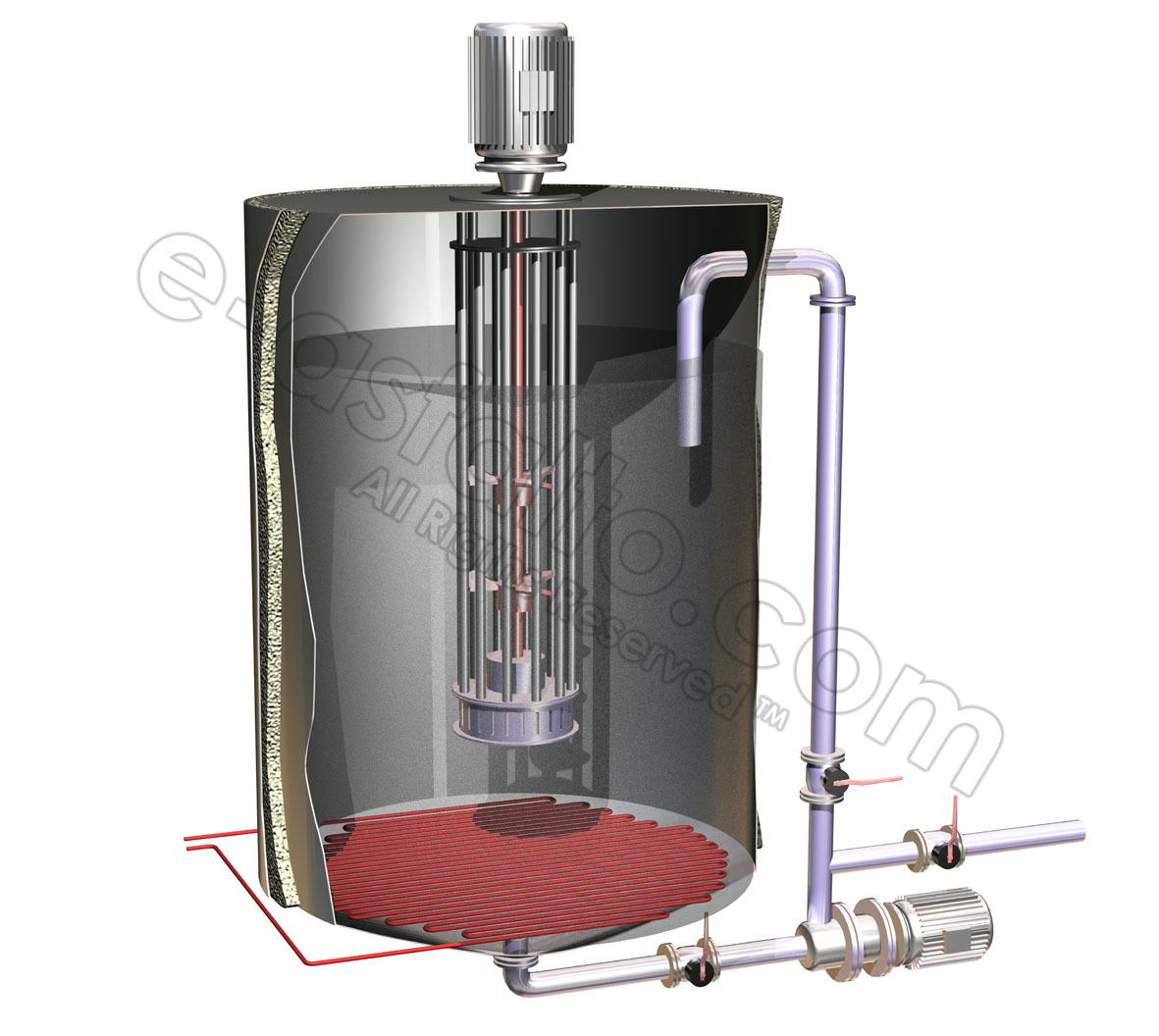
Inline High
Shear Mixers
For the continuous processing or batch
recycling of products, we have a complete range of high shear inline
mixers from the 0.25 kW laboratory unit to the 125 kW Multishear Mill.
Designed to exacting standards, their construction makes it physically
impossible for any materials liquid or solid to bypass the precision
rotor/stator workhead. The machine's own high volume centrifugal action -
from 10 Iitres/minute up m 250,000 litre/hour - will in most cases satisfy
the user's requirements without the need for auxiliary pumps
model registered ©
|
|
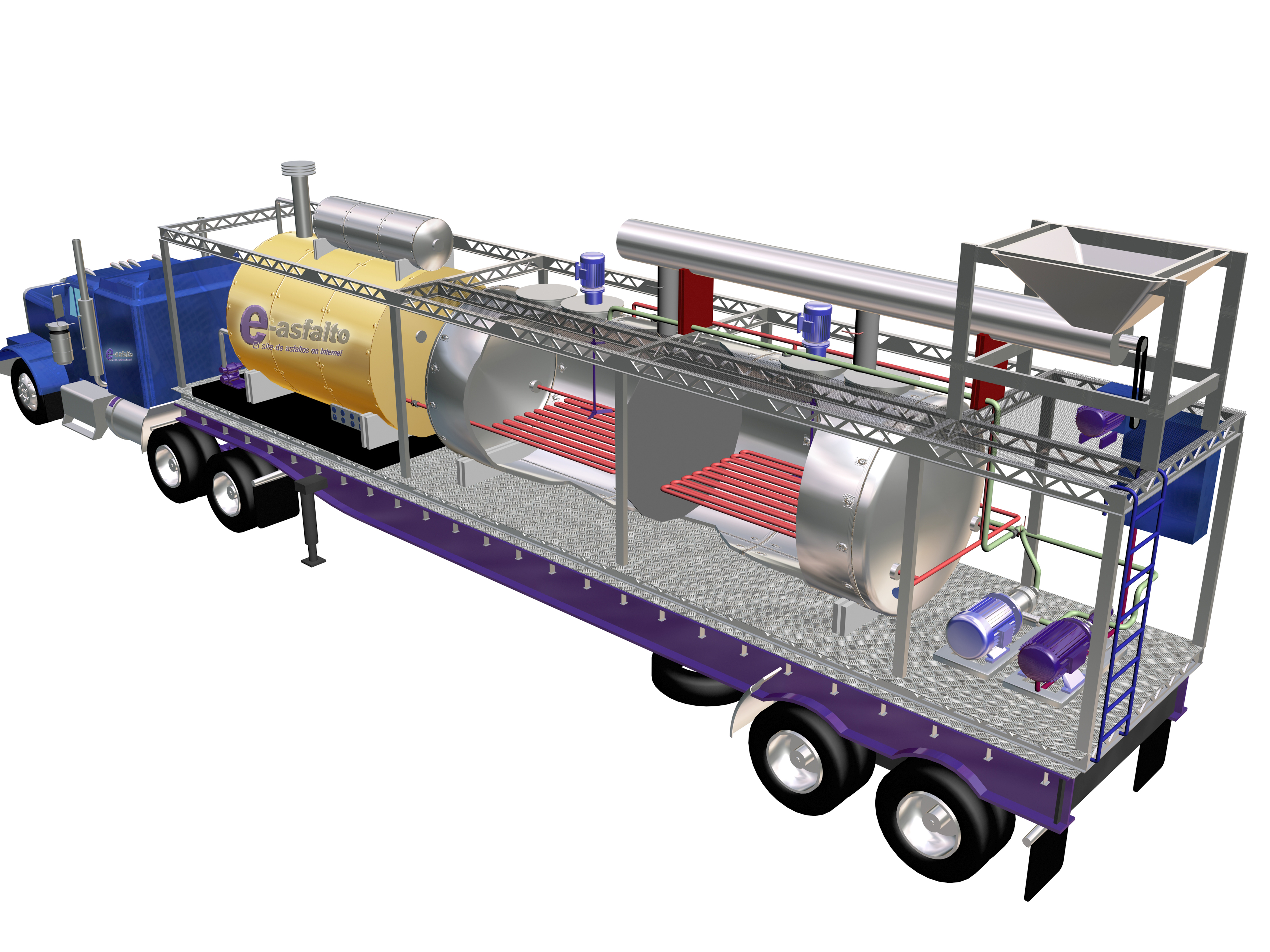
Portatile
Polymer Modified Asphalt Manufacture Plant
model
registered ©
|
|
NATURE (GRADE) OF POLYMER
For a given set of mixing conditions on a given
plant, the time required to achieve a homogenous blend of polymer and
bitumen will vary with the molecular weight build-up of the polymer, which
is reflected to some extent in the final viscosity of the polymer. Higher
molecular weight (or viscosity) will give rise to longer blending times, and
vice versa.
PHYSICAL FORM OF POLYMER
The physical form of the polymer influences the blending process in two
ways. The smaller the particle size of the polymer, the less reduction is
required in any disintegration step in the process. In addition, since
smaller particle size means larger surface area per unit mass of polymer,
penetration of the bitumen and swelling of the polymer is facilitated and
thus more rapid solution is achieved. Powdered polymer grades will therefore
disperse and dissolve more rapidly than porous pellets. Indeed, it may be
possible to blend powdered polymer with bitumen employing only low shear
equipment and without any disintegration stage. Whether this is cost
effective depends on the equipment available; if this is already high shear,
then the extra cost of powdered polymer may not be justified.
|
|
NATURE AND GRADE OF
THE BITUMEN
The bitumen plays a rather complex role in the
mixing process since both its composition and its viscosity affect the
blending in more than one way. Bitumens of higher maltenes content or
higher aromatics swell the polymer more rapidly than do those of higher
asphaltenes content. Whether this is an advantage depends on the equipment
used, e.g. excessive initial swelling will reduce the milling effect on
the polymer when passed through high shear mixers. Thus in this equipment
the shortest premix time compatible with initial dispersion of the polymer
in the bitumen should be employed. However, if a powdered grade of polymer
is being used, with low shear mixing, rapid swelling will be beneficial.
Low viscosity in a bitumen is helpful in increasing speed of penetration
and swelling of the polymer particles. If the viscosity at blending
temperatures is low, the disintegration effect on passing through the
milling step will be improved and more rapid particle size reduction will
result. Initial pre-dispersion will also be aided by low viscosity of the
bitumen. It is unlikely that the selection of a bitumen will ever be made
solely on the basis of its viscosity-temperature curve or its speed of
penetration into the polymer; the performance aspects of the finished
blend are likely to be the dominant factors in the choice of bitumen, and
the mixing process will generally be tailored to the formulation.
Mini Lab equipment used for 0,5 liter capacity
multi-purpose laboratory
mixers offer proven and unsurpassed efficiency in day to day laboratory
work. Engineered with the same care and attention characteristic of the
larger machines, they offer outstanding reliability and are perfectly
suited to small scale production work. They also provide an accurate and
easy means of forecasting the performance of larger machines under full
scale working conditions.
See more information:
|
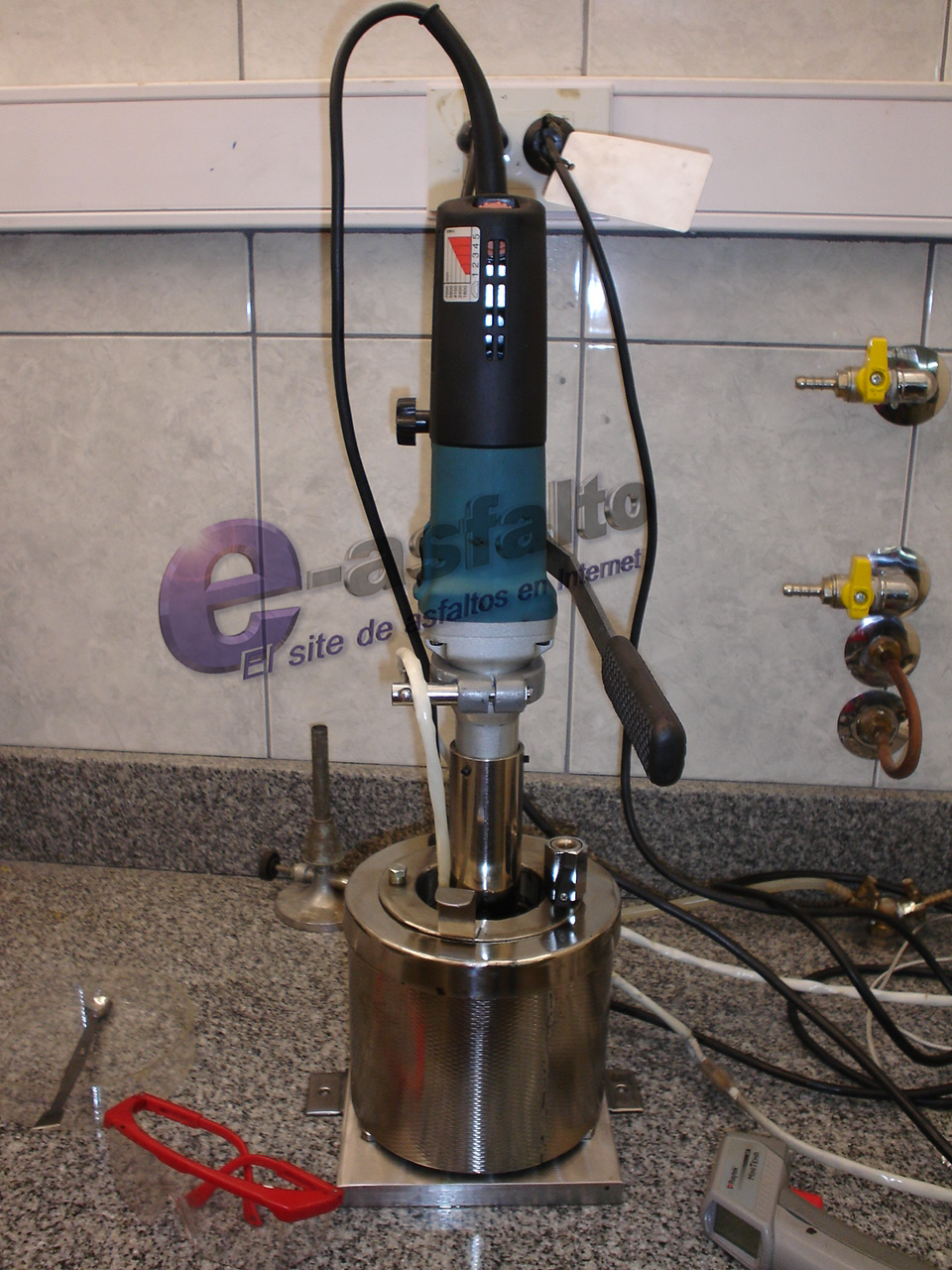
model registered ©
|
TYPE OF EQUIPMENT
Although there is a wide variety of
mixers and dispersers on the market, these can in broad terms be divided
into low shear and high shear appliances. In the former, typically paddle or
propeller type, no particle size reduction of the polymer takes place, the
action being confined to the swelling and dissolving by the bitumen. The
mixer serves to maintain homogeneity of composition and uniformity of
temperature, providing little heat input itself. In the latter there is a
stage in which the polymer particles are physically reduced in size by
mechanical/hydrodynamic shear in a rotor-stator combination accompanied by a
significant input of heat energy to the mix. Such equipment, whilst
functioning as a grinding stage, also provides rapid and efficient
dispersion and mixing of the plymer in the bitumen. High shear equipment
exists in two forms-the immersion type and the passthrough type. In the
former, as the name implies, the rotor-stator combination is mounted on a
shaft and immersed in a tank of material, depending on the efficiency of the
mixing head to circulate material and achieve homogeneity. In the latter the
material is positively passed through the milling equipment mounted in-line
between two vessels either by an auxiliary pump or by the action of the mill
itself in combination with the head due to gravity depending on the plant
layout. Experience has shown that this type of equipment, which ensures that
all of the mix passes through the rotor-stator gap, gives much more rapid
disintegration-and thus solution-of the polymer than does the immersion type.
TIME-TEMPERATURE PROFILE DURING MIXING
The ideal mixing process would involve the lowest possible temperature
for the shortest possible time (compatible with complete incorporation of
the polymer into the bitumen) both from the point of view of economics and
to minimise any changes in bitumen or polymer resulting from thermal effects.
Whilst the time cycle is a function of the efficiency of mixing and solution,
the temperature will to a large extent be a function of the bitumen chosen
and its requirements to achieve mobility and initial swelling of the polymer.
However, empirically, it has been found that for penetration bitumens used
in combination with polymer an operating temperature range of 170-190°C is
generally satisfactory. Temperatures above this must be avoided for reasons
which are discussed later. |
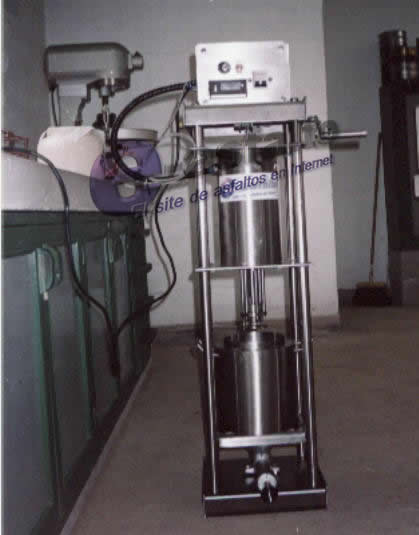 |
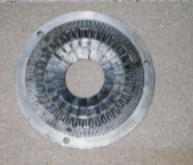 |
|
CONTROL OF BLENDING
For either system described above,
or for any other equipment, there will always be the need to establish
empirically the optimum conditions for a particular formulation. In order
to do this, a method of determining the progress of dispersion and
solution of the polymer is required. The simplest method available is the
`stretched film' test where undissolved/ swollen particles of rubber
appear as dark spots when a thin film of the blend is viewed by
transmitted light. Other more sophisticated methods are available, e.g.
fluorescence microscopy or rotational viscometry, both of which may be
used to assess the degree of homogeneity of the blend. These latter
methods are suitable for an initial determination of the optimum blending
time. However, the rapid stretched film test is more appropriate as
process control technique. Additionally, in the laboratory, it is possible
to compare the change in viscosity during mixing of a range of
formulations with, e.g., a Haake viscometer and establish an order of
speed of blending. However a direct translation to blending times on
industrial scale is not possible.
|
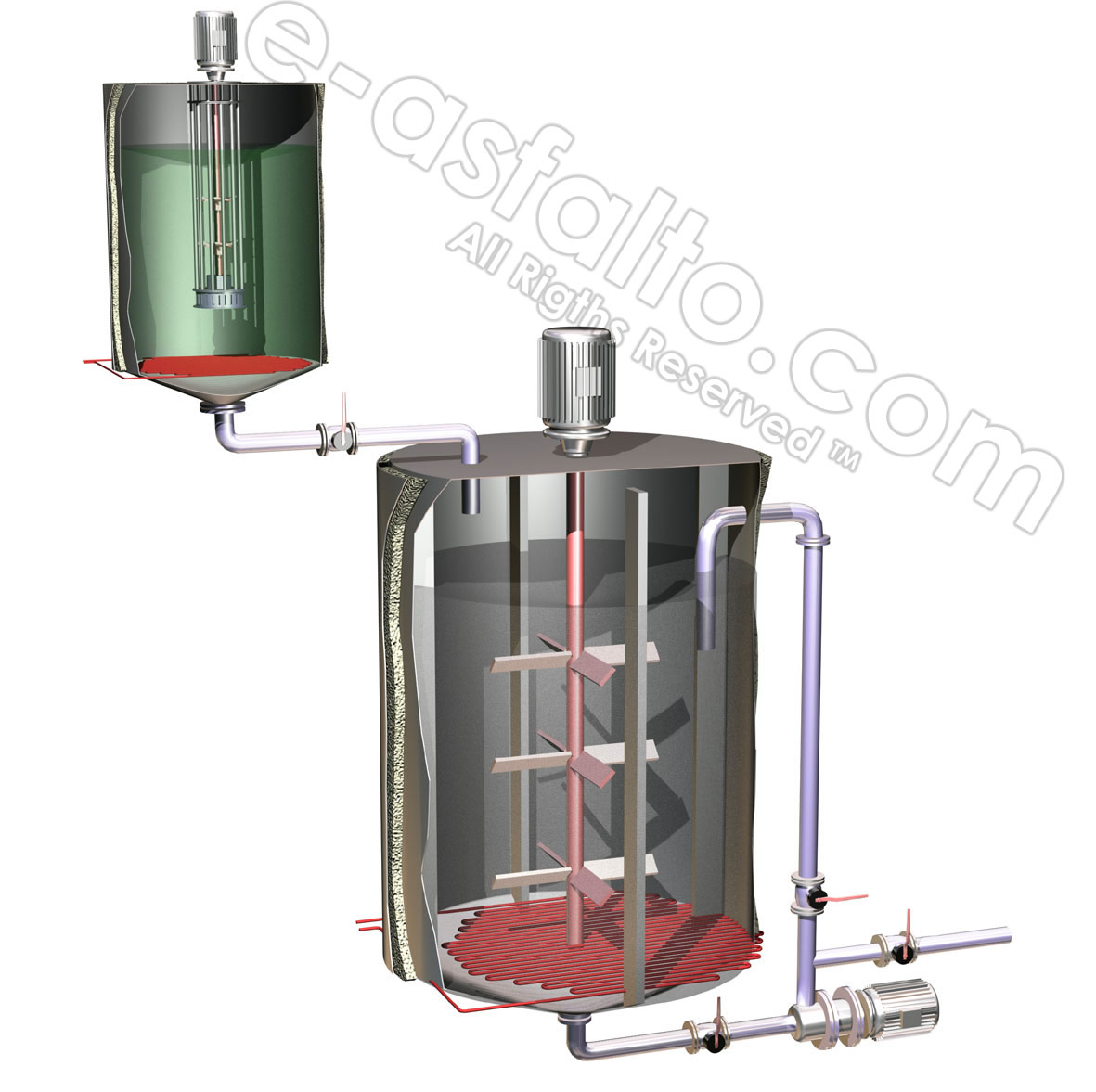
Disintegrator/Dissolver
Specifically developed far the disintegration and
solubilisation of solid rubbers and polymers, the equip twin workhead
assembly is ideal for the high speed production of bituminous compounds
model registered ©
|
STABILITY OF BLENDS
All polymer maintained at elevated temperatures for
long periods will be subject to three competing reactions: increase in molecular
weight, perhaps even leading to gelation, caused by cross linking of the
unsaturated bonds; a similar, oxygen induced, polymerisation; and breakdown
reactions. Additionally bitumens are subject to hardening on prolonged high
temperature exposure. All of these reactions can be minimised by maintaining
close control of operating temperatures and residence times in the mixing
equipment. Additional measures that will reduce any tendency to polymerise
include antioxidants, a relatively expensive route, or nitrogen blanketing of
the mixing vessel, which is very effective.
Basic Plant Construction And Layout
A bitumen/polymer production plant is essentially a simple construction
designed to efficiently mix and dissolve bitumen, residual aromatic extracts and
polymers to form bituminous compounds suitable for use as binders in asphalt
mixes, joint sealants, adhesives, roofing felt coatings, etc.
A plant
normally comprises three stages:
* Raw materials storage and
handling
* Mixing and dissolving
* Product storage and loading |
A typical plant will
comprise the following:
* Two raw materials bulk storage
tanks
* Polymer storage and handling area. one or two mixing vessels
* High shear disintegrator/mixer
* Product storage tanks
* Packing/loading facility
* Boiler room (hot oil facility)
* Control room |
In addition, there is a requirement for plant
utilities such as electricity, water, compressed air, hot oil heating, etc., and
for facilities such as a laboratory and offices. The ground area required for a
plant will depend upon the maximum throughput of the plant.
See More information in Spanish:
e-asphalt.com
will be happy to quote special machines or proyect plant
on receipt of details of composition of the product, etc.
More Information Send Mail to:
info@e-asfalto.com
Copyright © 2005-10 | All Rigths
Reserved. | Home | Buenos Aires Argentina
TELFAX: 005411-4754-9374 / 6351-6288 (whatsapp) / 5931-8727





